Bhakti Movement in India - Proponents of Bhakti Movement | 11th History : Chapter 13 : Cultural Syncretism: Bhakti Movement in India
Chapter: 11th History : Chapter 13 : Cultural Syncretism: Bhakti Movement in India
Proponents of Bhakti Movement
Proponents of Bhakti Movement
Kabir
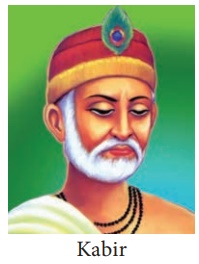
Kabir is probably the most important cultural
figure of medieval India. His iconoclastic poetry which ridiculed
ostentatiousness and ritual, and emphasized the universality of god won many
adherents. Little concrete historical evidence is available on his life. He was
probably a weaver. Said to be a disciple of Ramananda, he learnt Vedanta
philosophy from him. According to the popular Tazkirah-i-Auliya- i-Hind (Lives
of Muslim Saints), he was a disciple of the Muslim Sufi, Shaikh Taqi. Kabir was
a religious radical who denounced with equal zest the narrowness of
sectarianism, both Hindu and Islam. His message appealed to the lower classes
of Hindu community. The most salient features of his teachings is denunciation
of polytheism, idolatry, and caste. He was equally unsparing in his
condemnation of Muslim formalism. He was a true seeker after God, and did his best
to break the barriers that separated Hindus from Muslims. What appealed to the
millions of his followers through the ages, however, is his passionate
conviction that he had found the pathway to God, a pathway accessible to the
lowest as well as the highest. His poetry is still recited across large parts
of India.
Ravidas
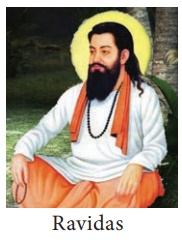
Ravidas was a poet saint of the bhakti movement
during the 15th to 16th century. Venerated as a guru (teacher) in the regions
of Punjab, Rajasthan, Maharashtra and Madhya Pradesh, the devotional songs of
Ravidas made a lasting impact upon the bhakti movement. The life details of
Ravidas are uncertain and contested. Most scholars believe he was born in a
family of tanners. Ravidas was one of the disciples of the bhakti saint-poet
Ramananda. Ravidas’ devotional songs were included in the Sikh Scriptures.
Ravidas spoke against social divisions of caste and gender, and promoted unity
in the pursuit of personal spiritual freedoms
Guru Nanak
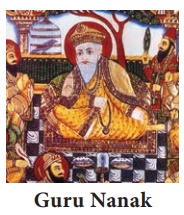
The saint with the biggest institutional influence
was Guru Nanak (1469–1539) who founded the Sikh religion which shows undoubted
syncretic influence. As a monotheistic religion Sikhism emphasized the oneness
of god and adherence to a strict morality. Over two centuries, under the
leadership of its ten gurus, Sikhism expanded swiftly in the Punjab region
winning numerous adherents. Sikh teachings resulted in the creation of a strong
sense of community. The politics of the times created conflicts with the Mughal
empire leading to persecution which resulted in the martyrdom of its gurus.
Guru Govind Singh was the last guru. After him the Granth Sahib was considered
the guru. While the teachings of Guru Nank is the Adi Granth. The Guru Granth
Sahib, part from the teachings of its other gurus, incorporates the writings of
many Bhakti poets and Sufi saints such as Ramananda, Namadeva, Kabir and Sheikh
Farid.
Chaitanya (1485–1533)
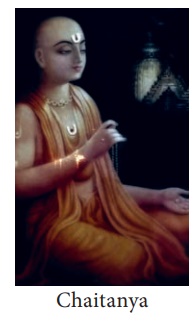
Chaitanya of Bengal represents an aspect of the bhakti movement that is very different from that seen in the lives and teachings of Kabir and his successors. Chaitanya’s concern, unlike that of Kabir, was not with Chaitanya bringing people to an understanding of a God, beyond all creeds and formulations; it was to exalt the superiority of Krishna over all other deities. It was, in other words, a revivalist, not a syncretic movement, a return to a worship of Vishnu under one of his most appealing forms, the loving ecstatic Krishna.
The Bengal Vaishnavites did not try to reform
Hinduism. Instead, they emphasized devotion to Krishna. Chaitanya, however,
made disciples from all classes. He popularised the practice of group
devotional singing accompanied by ecstatic dancing. His movement became popular
in Bengal and Orissa.
Namadeva

Namadeva, a son of a tailor and an inhabitant of
the village of Naras- Vamani in Satara district of Maharashtra, under the
influence of Saint Janadeva, was converted to the path of bhakti. A staunch
devotee of Vitthala of Pandarpur, Namdeva spent much of his time in worship
along with his followers, chanting mostly in his own verses. He wrote many abhangs (songs composed and sung by
saints in Maharashtra in praise of God’s glory) in Marathi and Hindi. He
travelled as far as Punjab where his teachings became so popular that they were
later absorbed in the Guru Granth.
Love god with all your heart to lead a pious life surrendering everything to
him with steadfast devotion is the essence of his message.
Ramananda (1400-1470)
While Chaitanya of Bengal belonged to the
philosophical school of Madhavacharya (a chief advocate of Dvaita school of
vedhanta), Ramananda was of Ramanuja’s philosophical thought.
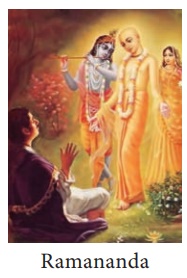
RamanandawasbornatPrayag(Allahabad) and received
his higher education in Hindu religious philosophy at Banaras and joined the
school of Ramanuja as a preacher. He visited the holy places of North India and
preached Vaishnavism. Ramananda introduced radical changes in Vaishnavism by
founding his own sect based on the doctrine of love and devotion to Rama and
Sita. He preached equality before God. He rejected caste system, particularly
the supremacy of Brahmins as the sole custodians of Hindu religion. The people
from the lower strata of the society became his followers. His twelve disciples
included Ravidas, Kabir and two women. Ramananda was the first to preach his
doctrine of devotion in Hindi, the vernacular language. It gained him a good
deal of popularity among the people of all classes. His followers were divided
into conservative and radical schools.
Mirabai (1498-1546)
Mirabai was born in Kudh of Merta district of Rajasthan. She was the great granddaughter of Rana Jodhaji, founder of Jodhpur. She was married to Bhoj Raj, son of Rana Sanga of Mewar. She became a devotee of Lord Krishna, left the palace and began singing her songs (bhajans) and preaching the path of love on God. Mirabai preached the worship of God in the name of Krishna and stressed that no one should be deprived of His divine grace on the ground of birth, poverty, age and sex.

Her devotional songs and lyrics constitute a rich
cultural heritage. Her bhajans are
sung with fervour to this day. Her teachings carried the message of divine
worship to almost every Hindu household.
Sur Das
Sur Das lived at the court of Akbar and was
popularly known as the blind bard of Agra. Sur Das is believed to have been a
disciple of Vallabacharya who was a Vaishnava preacher in the Sultanate period.
Vallabhacharya was the founder of Pushtimarga (way of grace) . Sur Das preached
religion of love and devotion to a personal God. He wrote inspiring and moving poems, Hindi poems about Lord
Krishna. Krishna’s bal lila constitutes the first great theme of Sur Das
poetry. According to him, love is a sublimated theme representing
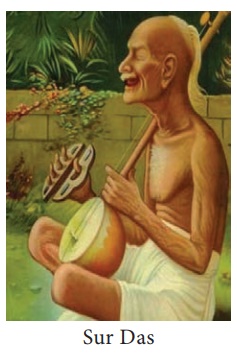
The
intensity of passion displayed by the gopis
is an expression of the natural attraction of the human spirit towards the divine
soul. His popular works are Sur Sagar, Sur Saravali and Sahitya Lehari. His
monumental work Sur Sagar or Sur’s Ocean is a story of Lord Krishna from the
birth to the departure for Mathura.
Tuka Ram
Tuka Ram was born in 1608 in a village near Poona,
Maharashtra. He was a contemporary of Maratha Shivaji and saints like Eknath
and Ramdas. After his early life as a trader he started spending his time
singing devotional songs in praise of his favourite deity Lord Vithoba of
Pandarpur.
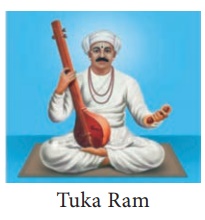
Tuka Ram believed in a formless
God.Accordingtohim,itwasnotpossibleto enjoin spiritual joy with worldly
activities. He stressed the all -pervasiveness of God. He rejected Vedic
sacrifices, ceremonies, pilgrimages, idol worship, etc. He also preached the virtue
of piety, forgiveness and peace of mind. He spread the message of equality and
brotherhood. He tried to foster Hindu-Muslim Unity. Some of his verses are
devoted to this theme. He wrote his abhangas
in Marathi
Related Topics